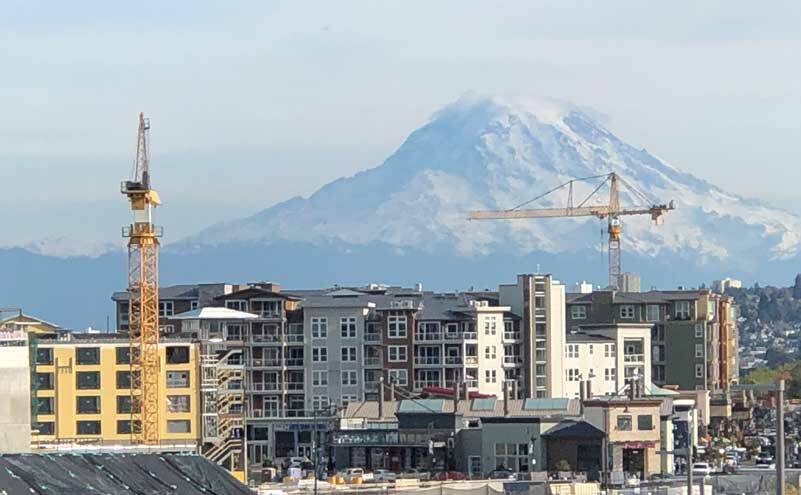By Morf Morford
Tacoma Daily Index
Zoning essentially began in 1921.
Before that, residential units from single family to boarding houses to apartment complexes to businesses (from small industry to locally owned grocery stores) could be built alongside each other. You can still see this in some of the older neighborhoods of most American cities.
In short, just about anything could be built just about anywhere.
When it comes to cost, a generation ago, a home cost about three times the average income – in 2021, in most metro areas, that ratio is closer to seven times average annual income.
And if you think housing is split between the haves and the have-nots, earned income is even more extreme.
If you have a home, in the past few years values have increased by up to 20% (or more) annually in some areas and even in lower priced areas by about 10%.
Equity increases, and as it does, those with equity have increased their wealth dramatically, and those without equity are being left even further behind.
In neither case is this growth or loss in net worth deliberate or a reflection of moral or financial rectitude.
Our prosperity – or exclusion from it – is more, far more, than our work ethic or intentions; our movement, in either direction, is more the nearly inevitable result of a near-gravitational force.
Some call this an economic conveyor-belt, and every aspect of our lives, from residential zip code to genes to family connections, frames and reinforces this bifurcating principle that seems to, without us even noticing, direct our lives.
In the real estate world, with increasing prices, renters are often forced out as owners find record prices for their homes.
Our housing “boom” (steady increase) in prices has been essentially uninterrupted since 2012 – by far the longest housing boom in US history.
Higher end housing – in higher end neighborhoods was built for obvious reasons; higher profit margin and lower risk.
How did COVID impact the housing market?
In the pre-COVID market, workers retired and often downsized or, if needed, moved to a senior residence or even a care facility.
This, on a nearly predictable schedule, opened up housing for young families.
For many reasons, this is not happening now.
Many home owners don’t want to move, or might have health related reasons for avoiding care facilities. And for many families, adult children, dislocated by work or housing changes, are moving in with their parents (often with their children), thus keeping that home off the market even longer.
Under “normal” conditions, rising prices would inspire reluctant sellers to put their houses on the market.
For a variety of reasons, that’s not happening. Prices are going up by the week, but it seems that fewer houses are on the market.
What goes up, must do something
The traditional child’s question “How high is up?” might be the most relevant question of the real estate market of the early 2020s.
In traditional capitalism, the “invisible hand” of the marketplace will solve this (and any) economic problem by filling any gaps and, while making a hefty profit, take care of every social problem from food shortages to homelessness.
In Seattle’s South Lake Union neighborhood, for example, almost 3,000 housing units have been built since 2017.
In nearby Belltown, more than 2,500 units were built (between 2017 and 2021).
According to Rentcafe, that’s 10% of Seattle’s entire new rental stock.
And, in other Seattle neighborhoods, Yesler Terrace and Broadway, hosted 1,717 and 1,239 new units, respectively, in the last five years.
That adds up to about 10,000 new units – and that is only looking at Seattle. Greater King County, and of course Snohomish and Pierce counties have their own apartment and other housing construction growth.
And yet homelessness seems to increase, and become more entrenched, every day.
As always happens in the fall, housing sales have slowed, or at least (to a degree) stabilized.
Bidding wars have largely retreated, and houses stay on the market a bit longer.
But will housing prices go down?
I think it’s inevitable that housing prices will go down, but when, and by how much is anyone’s guess.
But we do have several leading indicators on where housing prices will be going – eventually.
We have several unique trends and features putting pressure on the housing market. Each one of these will have its impact, and the convergence and multiplier effect of these will frame our real estate market for years to come.
You may have heard the statistic that 11% of homes in America are occupied by single individuals.
This is, by far, the highest number of single occupancy housing units ever in our history – or any human history.
How many economies in the entire world have allowed individuals to afford to live on their own?
Or, to reverse the question, how many economies in the entire world have forced individuals to live on their own?
Who knows how long that 11% of us will stick to solo living, but for now, and the foreseeable future, family life, and for too many, home ownership is deferred semi-indefinitely.
Factor in interest rates, zoning changes, a pandemic or two, a world wide drop in birth rates and climate change and you have a real estate market with more variables than any of us could juggle.
Add in the massive numbers of down-scaling Boomers who are, or will be, putting their homes on the market and you have the recipe for a housing market that has as much possibility for a downside as the recent market has had for an upside.
Eventually.





